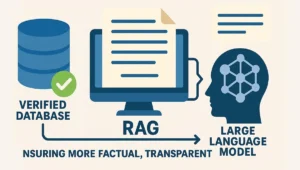The integration of artificial intelligence is swiftly establishing itself as a pivotal element in the forthcoming advancements of contemporary medicine. Envision an algorithm adept at scrutinizing tens of thousands of MRI images, not limited to mere observation, but genuinely comprehending them, identifying the earliest and most nuanced indicators of Alzheimer’s disease long before any human expert could. Such abilities are no longer hypothetical; they are transitioning into actuality, facilitating earlier interventions, enhancing diagnostic precision, and transitioning from a reactive approach to one that emphasizes prevention. AI in healthcare must go beyond intelligence – it must be built on transparency, accountability, and trust. AI has a wide range of applications in healthcare, from forecasting disease outbreaks to tailoring medication plans according to a person’s unique genetic profile, and its potential keeps growing all the time.
However, alongside this enthusiasm exists a more subdued yet disconcerting truth: the inherent risks that are woven into the very fabric of these systems. Numerous models that hold the potential to transform diagnosis and treatment are contingent upon sensitive patient information data that is susceptible to misuse, distortion, or mishandling. What are the implications when a life-saving algorithm is predominantly developed using data from a singular demographic and is subsequently implemented across heterogeneous populations? The outcome can be alarmingly erroneous predictions. Even more concerning is the possibility that the medical records utilized for training these systems, which contain highly personal and intensely confidential information, may be compromised or disclosed. These scenarios are not mere theoretical constructs; they represent tangible threats that healthcare organizations confront in contemporary practice.
This represents the fundamental contradiction inherent in artificial intelligence within the realm of healthcare: the advancement of medical science increasingly hinges on data, yet data simultaneously constitutes its most susceptible resource. The very patient information that fuels innovation has the potential, if mishandled, to undermine the essential trust upon which effective medical practice is predicated. Patients trust healthcare professionals with their personal information, assuming it will be used in a fair and responsible way and kept safe with great care. Any violation of that trust, whether due to carelessness or systemic oversights, can yield extensive repercussions, impacting both individuals and the healthcare systems designed to safeguard them.
It is within the dynamic interplay between advancement and safeguarding that the phenomenon termed the “Privacy Headache” arises. Moreover, this is not merely a fleeting issue; it stands as a quintessential dilemma of the artificial intelligence epoch in the field of medicine. Progress is contingent upon our ability to confront this challenge. It’s important that we tackle this issue with well-thought-out plans instead of quick fixes that don’t address the real problems. For AI to truly change healthcare for the better, it has to do so in a way that supports and helps the people it’s meant to serve.
Why “Open Source” Isn’t Enough: The Critical Need for “Truly Open” AI and the Black Box Problem
When people talk about transparency in artificial intelligence, the conversation often starts with one phrase: “open source.” It’s become a quick way to talk about accountability, the idea that if the code is open, the system must be safe, fair, and trustworthy. But in healthcare, where a mistake can cost a life, this idea doesn’t always work.
The main issue is what’s often called the “black box.” Many of the strongest AI systems, even those called open source, are still hard to understand. You might be able to download the code or look at how the model is built, but that doesn’t always show the full picture. In most cases, we don’t know exactly what data the models were trained on, how they make their decisions, or the steps that lead to their predictions. This lack of understanding is a major problem in medicine, where decisions must be clear and justified, not just effective.
Real accountability in AI needs more than just having access to the code. It needs a much deeper level of transparency that covers the whole life of a model. That’s the idea behind what we might call “Truly Open” AI, a system built around four key parts:
- Training Data Transparency: Just saying what kind of data was used isn’t enough? We need to know where the data came from, how it was collected, which groups it includes (and which are missing), and how it was prepared. This information is important for finding hidden problems or unfair parts.
- Source Code Transparency: Open source, as it’s usually understood, means being able to look at the full code and how the model is built. That’s still important. But it’s only one part of the whole picture.
- Evaluation Transparency: How was the model tested? What were the standards used? What results were important, and how did the system work across different groups or situations? Being open about this means others can test the model again and get the same answers.
Training Process Transparency refers to keeping track of all the training sessions, the specific settings that were used, the methods applied to improve the model’s performance, and any modifications that were made throughout the development process. This helps us understand not just what the model is, but how it was created.
These layers of openness aren’t just ideas from textbooks. They’re real needs that are necessary. Without them, it’s really hard to check models for hidden biases or differences in how they work for different groups of patients. Being able to repeat and check scientific work depends on having access to all the parts of the process. And for groups like the FDA, which has to make sure a tool is safe and works well in real medical situations, just showing a little openness isn’t enough.
That’s why the black box is so risky. In healthcare, if a decision isn’t explained, just saying its accurate isn’t enough. Doctors need to know why an AI system chose one diagnosis over another. Patients should know if the model used to look at their case was trained on people similar to them. And regulators need to follow every step of a model’s development if they’re going to allow it to be used in real medical settings.
Open source is a good beginning. But if we want AI to be reliable in medicine, we need to go further than just starting.
FlexOlmo: Privacy by Design, Not by Afterthought – The Architectural Solution
The need for trust built into systems is especially important in healthcare, and that’s exactly where FlexOlmo makes a difference.
It’s not just another AI tool. It shows a clear change in thinking: privacy, security, and compliance can’t be added later. They have to be part of the system from the start. This idea, called Privacy by Design (PbD), is central to FlexOlmo’s structure. Most AI platforms are made to run in the cloud, but FlexOlmo is different.
It’s built to work on-premise. This means healthcare organizations, hospitals, research labs, and clinics can set up and use the whole system within their own secure networks. Patient information stays inside those walls. There’s no sending data to outside servers or exposing it to external systems. This level of control and ownership isn’t just comforting, it’s often required by law.
By running on-premise, FlexOlmo greatly lowers the chance of data leaks or being intercepted. It also helps meet the rules for managing private health information, like HIPAA in the U. S. and GDPR in Europe. For places that handle electronic health records, this isn’t just a choice, it’s a legal requirement. But FlexOlmo does more than just run locally.
True to its “Truly Open” approach, it offers full-stack transparency. That includes access to the training data (with details on where it came from and how it’s structured), the full source code, tools for testing and evaluation, and detailed records of how the model was trained, including its settings and parameters. In short, FlexOlmo isn’t just a tool that works; it’s a system you can completely look into, check, and understand.
This openness isn’t just an extra. It’s a key part of the system. It allows IT teams and compliance officers to review everything. Researchers can find where bias might be coming from. Security experts can make sure data is handled properly. And regulators can examine the whole life of the model, how it was built, how it performs, and how it keeps data safe.
In this way, flexOlmo gives more than just a product. It shows what secure, responsible, and future-focused healthcare AI can be. It’s not just built to keep things private, but it also follows an open approach, making it ready to deal with the special needs of today’s medical field.
From Theory to Practice: Real-World Examples of Secure and Meaningful Use in Healthcare, the benefits of flexOlmo are not just ideas on paper. They come to life in the everyday, complicated, and high-pressure tasks that doctors and hospitals face. The choices made in its design, especially around keeping things private and being clear about how it works, are not just about how it’s built. They make real use cases possible that would otherwise be hard to do or very risky.
Case Study 1: Safe Analysis of Unstructured Clinical Notes for Drug Safety Picture a big hospital that has just started using a new medicine. They want to watch for any harmful side effects early on, but the most helpful clues, like quiet complaints, informal comments from doctors, and detailed reports of symptoms, are hidden in unstructured clinical notes. Normally, using AI to study these notes would mean sending them to an outside service, which causes worries about exposing patient data.
With flexOlmo, that risk is gone. The model runs entirely inside the hospital’s system. Sensitive text data never leaves the network. In real time, flexOlmo examines these notes and finds possible side effects of the drug that might have been missed. It helps keep drugs safe while keeping patient information private, not just in theory, but in actual daily work.
Case Study 2: Fixing Bias in AI for Fair Patient Care At a university hospital, a group of researchers is creating an AI tool to help diagnose a common skin condition. The tool works well for some patients, but not for others. When tested on people with darker skin, the tool’s accuracy drops a lot. The team used FlexOLMO’s “Truly Open” platform, which lets them see exactly what’s happening.
They get full access to the data used to train the model and the results from testing. They find out the problem: the training data has too many images of lighter skin tones. Using this new information, they gather a wider range of pictures, retrain the model, and test its performance once more. The results are much better, and the tool now works well for all skin types. In healthcare, this isn’t just about making the tool better. It’s about being fair, ensuring patients are protected, and creating trust.
Case Study 3: Working Together Safely with Federated Learning Imagine a group of hospitals working together on a rare disease. None of them have enough patient data to build a reliable AI model, but it’s hard to share data because of legal and ethical issues. That’s where FlexOLMO comes in. Each hospital keeps its data at its own location. They use FlexOLMO to train a model on their own secure data. Then, they send encrypted updates of the model to a central server. These updates are combined to create a better, more powerful model. No patient information ever leaves the hospital. But the final AI benefits from the data and experience of many locations. This method is especially crucial in fields such as cancer research, rare genetic disorders, and personalized medicine, where there’s not a lot of data available and protecting patient privacy is very important.
These aren’t just ideas for the future. They’re real examples of how AI can be used in a responsible way. It helps doctors and researchers do better work while protecting patient privacy. FlexOLMO makes this possible not by chance, but through careful design.
When a healthcare organization looks into using AI solutions, they often face a key decision early on. Should they build and manage the system themselves, or use external, proprietary APIs from big tech companies like OpenAI (GPT-4), Google (Vertex AI), or Amazon (Bedrock)?
At first, using these APIs might seem like a good idea. They are strong, can handle a lot of work, and are easy to connect with. But when it comes to dealing with private medical information, their shortcomings become clear. The risks involved are too great for just convenience.
flexOlmo was created for a different situation, one where keeping data under control, being able to track it, and having full authority over it are not just helpful, but essential.
Here’s how the two options compare:
| Criterion | flexOlmo (Truly Open, Privacy by Design) | Public Cloud APIs (e.g., GPT-4, Vertex AI) |
|---|---|---|
| Data Residency & Location | Privacy by Design, within the organization’s own network. No patient data leaves the system. | Data is transmitted to and processed by third-party data centers, often across borders. |
| Control Over Model & Data | Full control. Organizations can customize models, manage data preprocessing, and govern system behavior end-to-end. | Limited. Users interact through predefined API calls, with minimal visibility into how the underlying models function. |
| Auditability & Transparency | Complete. Access to training data, source code, evaluation scripts, and training logs allows for full-stack audits. | Opaque. No insight into the data used, training history, or internal logic. |
| Security of Sensitive Data | Built to protect. No third-party transit or storage. Reduces exposure risk. | Inherently risky. Even with encryption, data moves through external systems with unknown levels of protection. |
| Regulatory Compliance | Easier to demonstrate. Transparency and local control align well with HIPAA, GDPR, and similar frameworks. | Complex. Compliance relies on legal agreements and indirect guarantees from vendors. |
| Cost Model | Infrastructure-based. Predictable costs scale with internal usage and hardware capacity. | Pay-per-use. Costs can scale unpredictably with traffic and token volume. |
| Customization & Fine-Tuning | Extensive. Organizations can adapt models to their domain, retrain on their own datasets, and trace changes over time. | Minimal. Often limited to prompt engineering or surface-level tuning. |
| Dependency | Low. Institutions own and control the entire stack. | High. Organizations are reliant on the vendor’s uptime, service terms, and update schedule. |
| Latency & Performance | Tuned for local networks and hardware. Faster response times in clinical settings. | Network-dependent. Delays can be introduced by connectivity or load on remote infrastructure. |
This isn’t just a list of features; it’s a reflection of different beliefs. Public APIs are designed for general use and work at a large scale across the internet. Flexolmo, however, is made for healthcare, where the stakes are high, the standards are strict, and there’s a strong need for responsibility.
For any organization that handles patient records, diagnostic systems, or results, the choice is clear. While convenience is important, control is even more critical, especially when it comes to people’s lives.
Conclusion:
The Future of Medical AI Isn’t Just Smarter, It’s Safer and More Accountable.
This article started with two ideas: one about what’s possible and one about what’s risky.
On one side, we see the big potential of AI to help with early diagnosis, personalized care, and making healthcare more efficient. On the other, we face serious issues like privacy problems, unfair treatment by AI, and decisions that aren’t easy to explain. These two sides aren’t opposing each other. They exist together, and finding the right path between them is the main challenge we face.
The issue of privacy isn’t a flaw in the system. It’s a result of how the system is built. When medical advances are based on data, how we manage that data becomes a question of ethics, law, and science. We can’t fix it with quick solutions or by keeping things hidden behind closed systems. The answer isn’t more smartness, it’s more honesty.
That’s why the future of AI in healthcare won’t be judged just by how smart our models are, but by how strict the standards we set for them.
It won’t be about how many people an algorithm affects, but whether those interactions were safe, clear, and fair. AI doesn’t just need to be smart — it also needs to be responsible.
Platforms like Flexolmo show that this vision is more than an idea. It’s a path forward. By building privacy into the design and being fully open, we can create systems that not only make predictions but also build trust. That trust, more than any number or result, will be the key to how AI changes medicine in the long run.
This isn’t about stopping innovation. It’s about guiding it in the right way.
References
- World Health Organization. “Ethics and Governance of Artificial Intelligence for Health.” Retrieved from https://www.who.int/publications/i/item/9789240029200/
- European Commission. “General Data Protection Regulation (GDPR).” Retrieved from https://gdpr.eu/
- U.S. Department of Health & Human Services. “Health Information Privacy (HIPAA).” Retrieved from https://www.hhs.gov/hipaa/index.html/
- Evalueserve. “The Ultimate Guide to Domain-Specific AI.” Retrieved from https://www.evalueserve.com/the-ultimate-guide-to-domain-specific-ai-ebook/
- Obermeyer, Z., & Mullainathan, S. “Dissecting Racial Bias in an Algorithm Used to Manage the Health of Populations.” Science, 366(6464), 447–453. Retrieved fromhttps://doi.org/10.1126/science.aax2342/
- OpenMined. “An Introduction to Federated Learning.” Retrieved from https://www.openmined.org/blog/what-is-federated-learning
- The Markup. “How We Examined Racial Bias in Health Care Algorithms.” Retrieved from https://themarkup.org/black-box/
- Dpocentre. “Data Retention – The big privacy headache” Retrieved fromhttps://www.dpocentre.com/data-retention-the-big-privacy-headache/
- gdpr info. “Privacy by Design” Retrieved from https://gdpr-info.eu/issues/privacy-by-design/
FAQ
What's the biggest privacy risk when using AI in healthcare?
The biggest risk is patient data exposure, either through poorly secured cloud platforms or biased models trained on limited demographics.
Is open-source AI really enough for medical applications?
No. Traditional open-source only covers code. Medical AI needs “Truly Open” systems that include transparent data, evaluation, and training processes.
What makes "Truly Open" AI different from standard open source?
It adds full access to training data documentation, model evaluation benchmarks, and training logs—not just the source code.
Why is on-premise AI deployment better for hospitals?
Because it keeps sensitive patient data within the institution’s own servers, reducing risks from external breaches and ensuring full control.
Can AI models really be biased? Even in medicine?
Absolutely. If trained on skewed datasets, models may underperform for underrepresented groups, leading to misdiagnoses or unequal care.
How does flexOlmo prevent algorithmic bias in clinical AI?
By offering full transparency into its training data and evaluation process, enabling teams to identify, audit, and correct biased model behavior.
What is federated learning, and why is it important in healthcare?
It’s a method where models are trained locally across institutions without sharing raw patient data—perfect for rare diseases and privacy-sensitive research.
Are public cloud AI services like GPT-4 safe for medical use?
They’re powerful but lack visibility and control. For high-stakes environments like healthcare, their “black box” nature poses serious trust and compliance issues.
How does flexOlmo support regulatory compliance like HIPAA or GDPR?
Its on-premise architecture and full audit trail capabilities make it easier to demonstrate data control and security to regulators.
What's more important in healthcare AI—accuracy or transparency?
Both matter—but without transparency, you can’t verify accuracy, detect bias, or build trust. In medicine, a black box is never enough.







